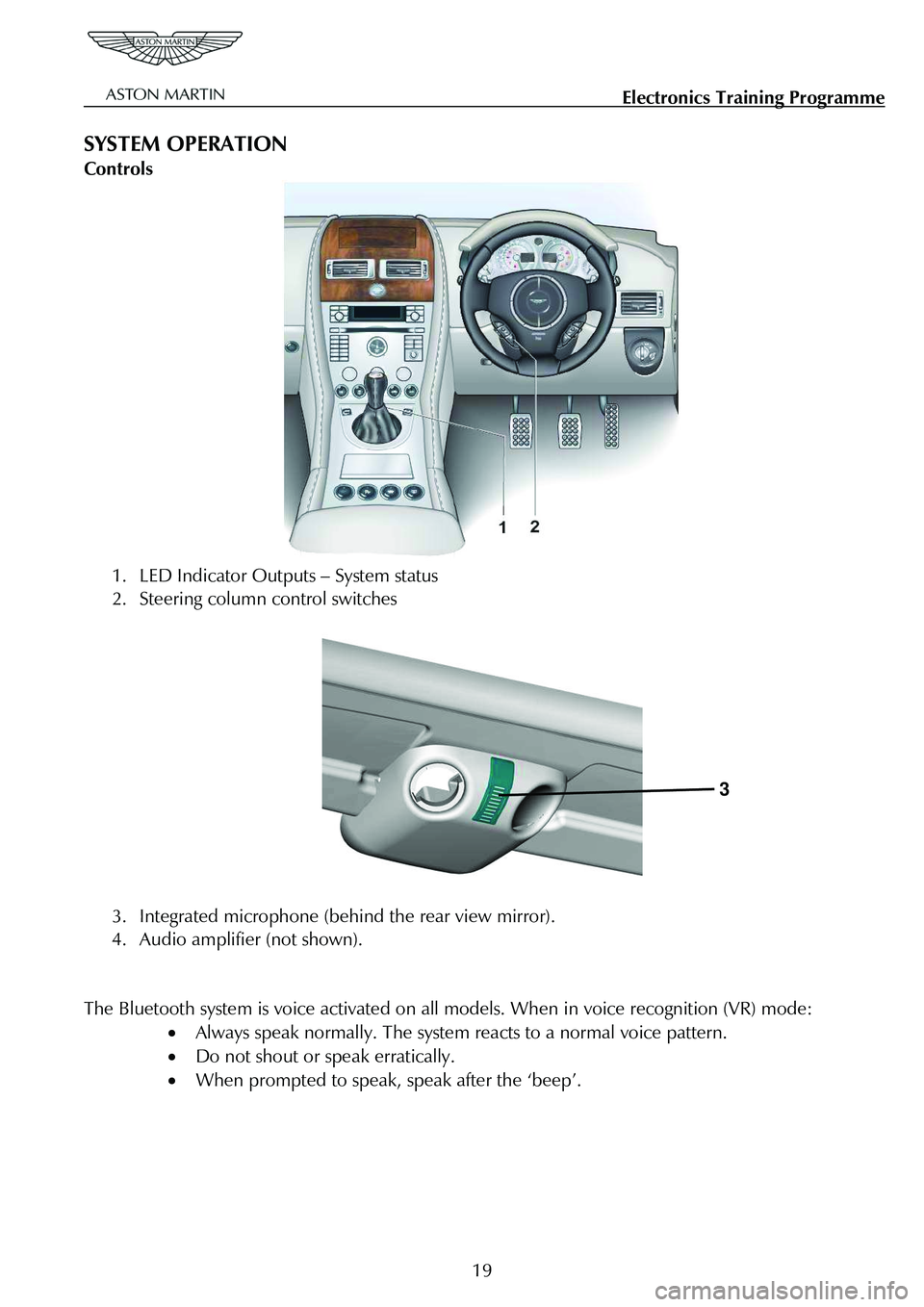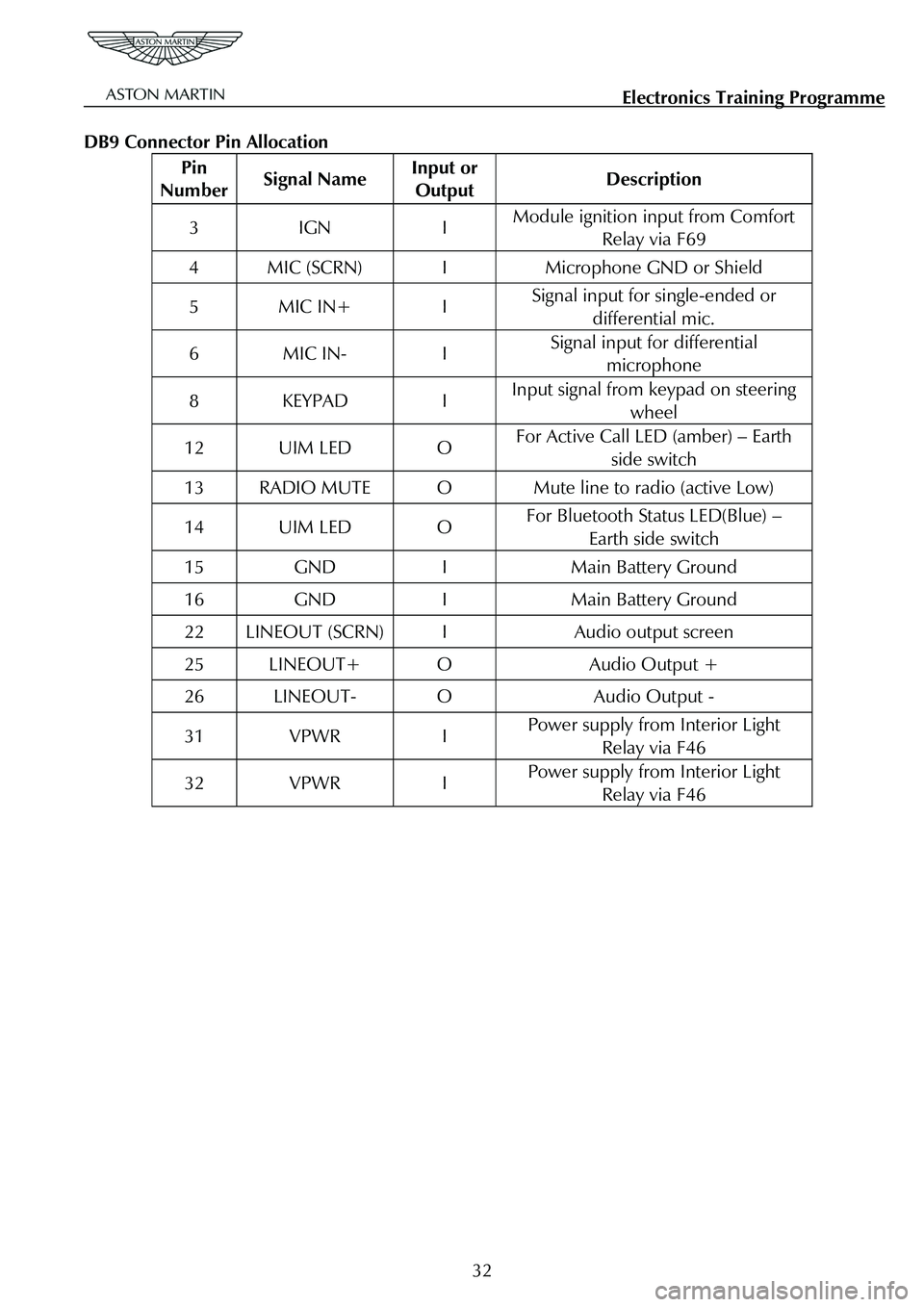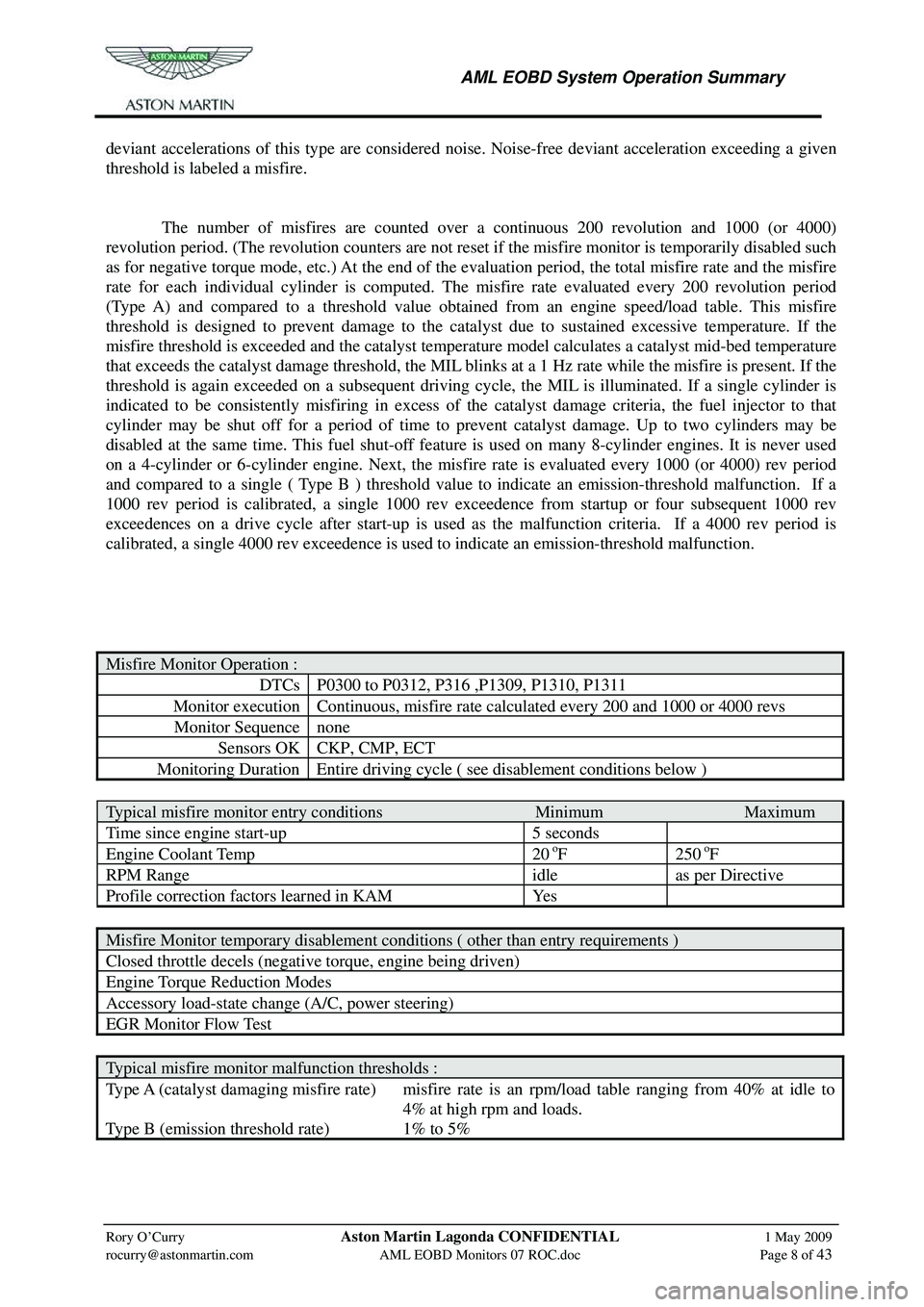steering ASTON MARTIN V8 VANTAGE 2010 Manual Online
[x] Cancel search | Manufacturer: ASTON MARTIN, Model Year: 2010, Model line: V8 VANTAGE, Model: ASTON MARTIN V8 VANTAGE 2010Pages: 947, PDF Size: 43.21 MB
Page 813 of 947

Electronics Training Programme
Steering joint
8
Page 814 of 947

Electronics Training Programme
Description
The Bluetooth Module controls the Bluetooth system on all cars. This module is a stand-alone unit,
which is not connected to any communication network on the car. The module is located on the
drivers side of the Instrument Pack (IP) ju st above the pedals (see page opposite).
The components of the system are:
1. Microphone
2. Bluetooth switches (steering wheel)
3. LED Indicator
4. Bluetooth Module
5. Amplifier (audio)
6. Switcher box (V8 Vantage only)
If a DB9 is installed with both the ‘in-car’ ph one and the Bluetooth systems and both systems are
active then the Bluetooth system will override the ‘i n-car’ phone system. An active call on the ‘in-car’
phone will be ended if a call is re ceived on the Bluetooth system or any of the Bluetooth menus are
used.
The Bluetooth module has been designed to meet the following parameters:
Parameter Units Nominal Lower Limit Upper Limit
Battery Voltage Volts N/A 10.5 16.0
Nominal Voltage Volts 13.2 12.2 14.2
Over Voltage (for 1 minute) Volts 24.0 18.0 25.0
Operating Current mA 225-300 <300uA (sleep) <1.5A
Room Temperature °C 25 15 35
Operating Temperature °C N/A -30 70
Storage Temperature °C N/A -40 85
9
Page 816 of 947

Electronics Training Programme
SYSTEM LAYOUT
V8 Vantage Layout
Bluetooth enabled and
paired phone
Bluetooth receiver module
Amplifier module
LED Indicator (Bluetooth display module)
Front speaker Switcher box
Microphone Steering column control
switches
Power Supply
Door speaker (drivers side) Door speaker
(passenger side)
11
Page 818 of 947

Electronics Training Programme
DB9 Layout
Bluetooth enabled and
paired phone
Bluetooth receiver module
Microphone
Amplifier module
Power Supply
Steering column control switches
LED Indicator (Bluetooth display module)
Door speaker (drivers side) Door speaker
(passenger side)
13
Page 820 of 947

Electronics Training Programme
INPUTS
The Bluetooth system relies on a number of signals it receives either from the car (via hard wiring) or
the users phone (via wireless Bluetooth communication network).
The Bluetooth system will only function if the us ers mobile phone has Bluetooth enabled and it is
‘paired’ to the car. For more information refer to the user’s guide for your mobile phone.
V8 Vantage Power Supplies
Description Supplied From Source Protection
Wakeup signal Central Electronic Module Comfort Relay F68 (5 Amp)
Power supply 1 Central Electronic Module Interior Lights Relay F46 (5Amp)
Power supply 2 Central Electronic Module Interior Lights Relay F46 (5Amp)
DB9 Power Supplies
Description Supplied From Source Protection
Wakeup signal Central Electronic Module Comfort Relay F69 (5 Amp)
Power supply 1 Central Electronic Module Interior Lights Relay F46 (5Amp)
Power supply 2 Central Electronic Module Interior Lights Relay F46 (5Amp)
V8 Vantage Signal Inputs
Input Description Signal Characteristic
MIC In Input signal from microphone Varying current signal direct from microphone
Keypad Steering wheel controls input Variable resistance to earth signal
DB9 Signal Inputs
Input Description Signal Characteristic
MIC In + Input signal from microphone Varying current signal supplied via amplifier
MIC In - Input signal from microphone Varying current signal supplied via amplifier
Keypad Steering wheel controls inpu t Variable resistance to earth
Screens
Some of the signals in and out of the Bluetooth modu le require screening to avoid interference being
picked up. A signal screen is a single wire running along side t he signal wire(s) which will absorb
electro magnetic interference (EMI).
The Bluetooth module on the V8 Vantage features only one screen so as to protect the signal from the
microphone. This screen wire is simply an earth but it is also used as a datum from which to reference
the microphone signal.
The Bluetooth module used on DB9’s features two screens. One is as on the V8 Vantage but is used
only as a screen (because the microphone signal from the amplifie r has two signal wires) and no
datum is required. The second screen on the module is used to screen the ‘Lineout’ signals to the
amplifier. As with the microphone scr een this wire is connected to earth.
15
Page 824 of 947

Electronics Training Programme
SYSTEM OPERATION
Controls
1. LED Indicator Outputs – System status
2. Steering column control switches
3
3. Integrated microphone (behind the rear view mirror).
4. Audio amplifier (not shown).
The Bluetooth system is voice activated on all models. When in voice recognition (VR) mode:
• Always speak normally. The system reacts to a normal voice pattern.
• Do not shout or speak erratically.
• When prompted to speak, speak after the ‘beep’.
19
Page 836 of 947

Electronics Training Programme
DIAGNOSTICS
V8 Vantage Connector Pin Allocation
Pin
Number Signal Name Input or
Output Description
3 WAKEUP I Module ignition input from Comfort
Relay via F68
4 MIC (SCRN) I Microphone GND
5 MIC IN+ I Signal input for single-ended
microphone direct from microphone
8 KEYPAD I Input signal from keypad on steering wheel
12 UIM LED O For Active Call LED (amber) – Earth
side switch
13 RADIO MUTE O Mute line to radio (active Low)
14 UIM LED O For Bluetooth Status LED(Blue) – Earth side switch
15 GND I Main Battery Ground
16 GND I Main Battery Ground
23 HF_SPKR + O Audio Output +
24 HF_SPKR + O Audio Output -
31 VPWR I Power supply from Interior Light Relay via F46
32 VPWR I Power supply from Interior Light Relay via F46
31
Page 837 of 947

Electronics Training Programme
DB9 Connector Pin Allocation
Pin
Number Signal Name Input or
Output Description
3 IGN I Module ignition input from Comfort
Relay via F69
4 MIC (SCRN) I Microphone GND or Shield
5 MIC IN+ I Signal input for single-ended or
differential mic.
6 MIC IN- I Signal input for differential microphone
8 KEYPAD I Input signal from keypad on steering
wheel
12 UIM LED O For Active Call LED (amber) – Earth side switch
13 RADIO MUTE O Mute line to radio (active Low)
14 UIM LED O For Bluetooth Status LED(Blue) – Earth side switch
15 GND I Main Battery Ground
16 GND I Main Battery Ground
22 LINEOUT (SCRN) I Audio output screen
25 LINEOUT+ O Audio Output +
26 LINEOUT- O Audio Output -
31 VPWR I Power supply from Interior Light Relay via F46
32 VPWR I Power supply from Interior Light Relay via F46
32
Page 854 of 947

AML EOBD System Operation Summary
Rory O’Curry Aston Martin Lagonda CONFIDENTIAL 1 May 2009
[email protected] AML EOBD Monitors 07 ROC.doc Page 8 of 43
deviant accelerations of this type are considered noise. Noise-free deviant acceleration exceeding a given
threshold is labeled a misfire.
The number of misfires are counted over a continuous 200 revolution and 1000 (or 4000)
revolution period. (The revolution counters are not reset if the misfire monitor is temporarily disabled such
as for negative torque mode, etc.) At the end of the evaluation period, the total misfire rate and the misfire
rate for each individual cylinder is computed. The misfire rate evaluated every 200 revolution period
(Type A) and compared to a threshold value obtaine d from an engine speed/load table. This misfire
threshold is designed to prevent damage to the cat alyst due to sustained excessive temperature. If the
misfire threshold is exceeded and the catalyst temperature model calculates a catalyst mid-bed temperature
that exceeds the catalyst damage threshold, the MIL blinks at a 1 Hz rate while the misfire is present. If the
threshold is again exceeded on a subsequent driving cy cle, the MIL is illuminated. If a single cylinder is
indicated to be consistently misfiring in excess of the catalyst damage criteria, the fuel injector to that
cylinder may be shut off for a period of time to pr event catalyst damage. Up to two cylinders may be
disabled at the same time. This fuel shut-off feature is used on many 8-cylinder engines. It is never used
on a 4-cylinder or 6-cylinder engine. Next, the misf ire rate is evaluated every 1000 (or 4000) rev period
and compared to a single ( Type B ) threshold value to indicate an emission-threshold malfunction. If a
1000 rev period is calibrated, a single 1000 rev exceedence from startup or four subsequent 1000 rev
exceedences on a drive cycle after start-up is used as the malfunction criteria. If a 4000 rev period is
calibrated, a single 4000 rev exceedence is used to indicate an emission-threshold malfunction.
Misfire Monitor Operation :
DTCs P0300 to P0312, P316 ,P1309, P1310, P1311
Monitor execution Continuous, misfire rate calculated every 200 and 1000 or 4000 revs
Monitor Sequence none
Sensors OK CKP, CMP, ECT
Monitoring Duration Entire driving cycle ( see disablement conditions below )
Typical misfire monitor entry conditions Minimum Maximum
Time since engine start-up 5 seconds
Engine Coolant Temp 20 oF 250 oF
RPM Range idle as per Directive
Profile correction factors learned in KAM Yes
Misfire Monitor temporary disablement conditions ( other than entry requirements )
Closed throttle decels (negative torque, engine being driven)
Engine Torque Reduction Modes
Accessory load-state change (A/C, power steering)
EGR Monitor Flow Test
Typical misfire monitor malfunction thresholds :
Type A (catalyst damaging misfire rate) misfire rate is an rpm/load table ranging from 40% at idle to
4% at high rpm and loads.
Type B (emission threshold rate) 1% to 5%
Page 938 of 947

SB-17-0298
February 2009 Page 1 of 5
SERVICE BULLETIN
To: All Dealers
For the attention of: Service Manager/After Sales Manager
Please copy to: The Dealer Principal
The Warranty Administrator
Aston Martin Technician(s)
The Parts Manager
Reference
SB-17-0298
Issued:
26 February 2009
Model: DBS, DB9, V8 and V12 Vantage
VIN Range: All
Subject: Headlamp Drying Out Procedure Page 1 of 5
Reason for this Service Bulletin
The headlamps of DBS, DB9, V8 and V12 Vantage models can get condensation on the inside surface of the lens.
If a customer complains that their vehicle has condensa tion in a headlamp, do the applicable procedure that
follows to remove the condensation.
Workshop Procedures
DBS and DB9 Vehicles
1. Turn the steering to get access to the headlamp access panel for the correct headlamp.
2. Lift the vehicle and make it safe.
3. Release the quarter-turn fastener and remove the
headlamp access panel (refer to Figure 1).
Figure 1
4. Remove the dip-beam bulb cover from the headlamp.
5. Install a battery vent tube (part number 1R12-372635-AA) (1) into the head lamp in the position shown in
Figure 2 and Figure 3.